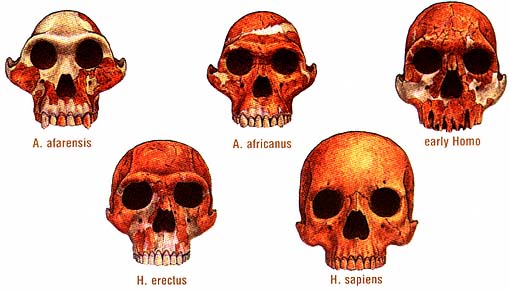Human Evolution
Studies in evolutionary biology have led to the conclusion that human beings arose from ancestral primates. This association was hotly debated among scientists in Darwin's day. But today there is no significant scientific doubt about the close evolutionary relationships among all primates, including humans.
Many of the most important advances in paleontology over the past century relate to the evolutionary history of humans. Not one but many connecting links—intermediate between and along various branches of the human family tree—have been found as fossils. These linking fossils occur in geological deposits of intermediate age. They document the time and rate at which primate and human evolution occurred.
Scientists have unearthed thousands of fossil specimens representing members of the human family. A great number of these cannot be assigned to the modem human species, Homo sapiens. Most of these specimens have been well dated, often by means of radiometric techniques. They reveal a well-branched tree, parts of which trace a general evolutionary sequence leading from ape-like forms to modem humans.
Paleontologists have discovered numerous species of extinct apes in rock strata that are older than four million years, but never a member of the human family at that great age. Australopithecus, whose earliest known fossils are about four million years old, is a genus with some features closer to apes and some closer to modem humans. In brain size, Australopithecus was barely more advanced than apes. A number of features, including long arms, short legs, intermediate toe structure, and features of the upper limb, indicate that the members of this species spent part of the time in trees. But they also walked upright on the ground, like humans. Bipedal tracks of Australopithecus have been discovered, beautifully preserved with those of other extinct animals, in hardened volcanic ash. Most of our Australopithecus ancestors died out close to two-and-a-half million years ago, while other Australopithecus species, which were on side branches of the human tree, survived alongside more advanced hominids for another million years.
Distinctive bones of the oldest species of the human genus, Homo, date back to rock strata about 2.4 million years old. Physical anthropologists agree that Homo evolved from one of the species of Australopithecus. By two million years ago, early members of Homo had an average brain size one-and-a-half times larger than that of Australopithecus, though still substantially smaller than that of modem humans. The shapes of the pelvic and leg bones suggest that these early Homo were not part-time climbers like Australopithecus but walked and ran on long legs, as modem humans do. Just as Australopithecus showed a complex of ape-like, human-like, and intermediate features, so was early Homo intermediate between Australopithecus and modem humans in some features, and dose to modem humans in other respects. The earliest

Early hominids, such as members of the Australopithecus afarensis species that lived about 3 million years ago, had smaller brains and larger faces than species belonging to the genus Homo, which first appeared about 2.4 million years ago. White parts of the skulls are reconstructions, and the skulls are not all on the same scale.
stone tools are of virtually the same age as the earliest fossils of Homo. Early Homo, with its larger brain than Australopithecus, was a maker of stone tools.
The fossil record for the interval between 2.4 million years ago and the present includes the skeletal remains of several species assigned to the genus Homo. The more recent species had larger brains than the older ones. This fossil record is complete enough to show that the human genus first spread from its place of origin in Africa to Europe and Asia a little less than two million years ago. Distinctive types of stone tools are associated with various populations. More recent species with larger brains generally used more sophisticated tools than more ancient species.
Molecular biology also has provided strong evidence of the close relationship between humans and apes. Analysis of many proteins and genes has shown that humans are genetically similar to chimpanzees and gorillas and less similar to orangutans and other primates.
DNA has even been extracted from a well-preserved skeleton of the extinct human creature known as Neanderthal, a member of the genus Homo and often considered either as a subspecies of Homo sapiens or as a separate species. Application of the molecular clock, which makes use of known rates of genetic mutation, suggests that Neanderthal's lineage diverged from that of modem Homo sapiens less than half a million years ago, which is entirely compatible with evidence from the fossil record.
Based on molecular and genetic data, evolutionists favor the hypothesis that modem Homo sapiens, individuals very much like us, evolved from more archaic humans about 100,000 to 150,000 years ago. They also believe that this transition occurred in Africa, with modem humans then dispersing to Asia, Europe, and eventually Australasia and the Americas.
Discoveries of hominid remains during the past three decades in East and South Africa, the Middle East, and elsewhere have combined with advances in molecular biology to initiate a new discipline—molecular paleoanthropology. This field of inquiry is providing an ever-growing inventory of evidence for a genetic affinity between human beings and the African apes.
Opinion polls show that many people believe that divine intervention actively guided the evolution of human beings. Science cannot comment on the role that supernatural forces might play in human affairs. But scientific investigations have concluded that the same forces responsible for the evolution of all other life forms on Earth can account for the evolution of human beings.


